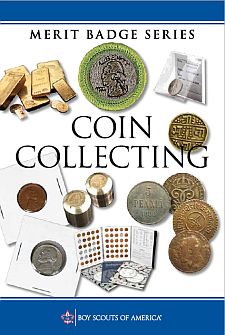- Understand how coins are made, and where the active U.S. Mint facilities are located.
- Explain these collecting terms:
- Obverse
- Reverse
- Reeding
- Clad
- Type set
- Date set
- Explain the grading terms Uncirculated, Extremely Fine, Very Fine, Fine, Very Good, Good, and Poor. Show five different grade examples of the same coin type. Explain the term proof and why it is not a grade. Tell what encapsulated coins are.
- Know three different ways to store a collection, and describe the benefits, drawbacks, and expense of each method. Pick one to use when completing requirements.
- Do ONE of the following:
- Demonstrate to your counselor that you know how to use two U.S. or world coin reference catalogs.
- Read a numismatic magazine or newspaper and tell your counselor about what you learned.
- Describe the 1999-2008 50 State Quarters® program or the 2010-2021 America the Beautiful Quarters® program. Collect and show your counselor five different quarters from circulation you have acquired from one of these programs.
- Collect from circulation a set of current U.S. coins. Include one coin of each denomination (cent, nickel, dime, quarter, half-dollar, dollar). For each coin, locate the mint marks, if any, and the designer's initials, if any.
- Do the following:
- Identify the people depicted on the following denominations of current U.S. paper money: $1, $2, $5, $10, $20, $50, and $100.
- Explain "legal tender."
- Describe the role the Federal Reserve System plays in the distribution of currency.
- Do ONE of the following:
- Collect and identify 50 foreign coins from at least 10 different countries.
- Collect and identify 20 bank notes from at least five different countries.
- Collect and identify 15 different tokens or medals.
- For each year since the year of your birth, collect a date set of a single type of coin
- Do ONE of the following:
- Tour a U.S. Mint facility, a Bureau of Engraving and Printing facility, a Federal Reserve Bank, or a numismatic museum or exhibit, and describe what you learned to your counselor.
- With your parent's permission, attend a coin show or coin club meeting, or view the website of the U.S. Mint or a coin dealer, and report what you learned.
- Give a talk about coin collecting to a group such as your troop, a Cub Scout pack, or your class at school.
- Do drawings of five Colonial-era U.S. coins.
- Describe three different ways to store a collection, and the benefits, drawbacks, and cost of each method.
- Do each of the following and explain to your counselor the design
features, designer name, designer initials, and where to find them for
each item:
- Collect a one-cent coin from the year group: 1959-2008 (that is, dated between 1959 and 2008) and a one-cent coin from the year group 2010-present. Explain how and why the one-cent coins issued in 2009 were different from either of the other two year groups.
- Collect two five-cent coins, one from each of these year groups: 1959- 2003 and 2006-present. Explain how and why the five-cent coins issued in 2004-2005 were different from either of the other two year groups.
- Collect a ten-cent coin from 1965-present.
- Collect a twenty-five-cent coin from 1965-1998, two examples from the 50-State Quarter®/territories Program 1999-2009, two designs from the America the Beautiful® program 2012-2021 and two designs from the American Woman Quarter® program (2022-2024). Explain the purpose of each of those programs.
- Collect a half dollar coin from 1965-present.
- Collect a dollar coin from each of these design groups: Susan B. Anthony 1979-81, Sacagawea 1990-2005, U.S. Presidents 2000-2014.
- Describe and discuss with your counselor the special reverse designs of the quarters, half dollar and dollar coin struck in 1975-1976 to honor the U.S. Bicentennial.
- Identify for your counselor the people depicted on current currency: $1, $2, $5, $10, $20, $50, and $100 notes. Explain where United States currency is printed.
- Do ONE of the following:
- Collect and identify for your counselor 20 different world coins from at least 7 different countries. Identify the country, major design elements, and denomination of each.
- Collect and identify for your counselor 20 different world paper money from at least 7 different countries. Identify the country, major design elements, and denomination of each.
- Collect and identify for your counselor 20 different tokens and/or medals. Identify the issuer and use of each.
- Complete one of the following and report to your counselor what
you experienced:
- Attend a coin show
- Attend a coin club meeting
- Tour a U.S. Mint facility or museum
- Tour a virtual exhibit (with your parent or guardian's permission) approved by your counselor.
BSA Advancement ID#:
35
Scoutbook ID#:
28
Requirements last updated in:
2024
Pamphlet Publication Number:
35874
Pamphlet Stock (SKU) Number:
E-Book Stock (SKU) Number:
Pamphlet Copyright Date:
|
|||||||
Source: SCOUTS BSA REQUIREMENTS 2024 (Pub # 33216 - SKU# 660535)
Page updated on: February 23, 2024









